![]()
- BBQ, Free Dive, Prizes !!
- Scuba Skills Tune-Up Event
- Top 10 Reasons To Do a Scuba Refresher Course
- CRF Two-Day PADI Specialty Course
- TV Shows
- Ready for the 2018 Lobster Season?
- Henderson Aqua Lock Dive Wetsuit
- Beneath the Sea Imaging Contest
- You Know Your Buddy Hates You If...
- How Did You Miss $53 Million?
- A Major Problem
- Newsletter Delivery Options
- Email or Address Change?
- T-Shirts For Sale
- ADA Guidelines and Policies
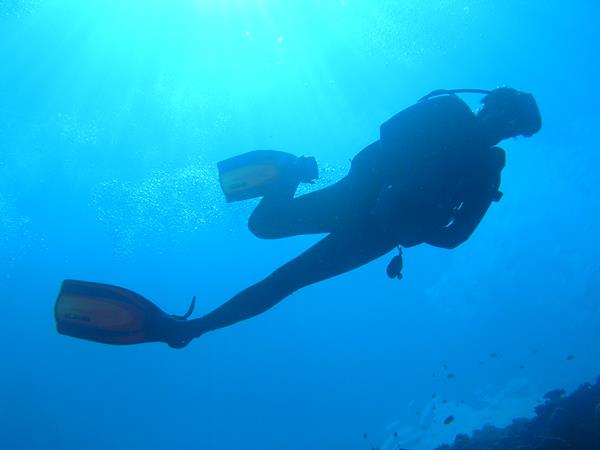
- When: Saturday, April 14, 2018
- Who: ADA members, family and friends. The cost of the BBQ is $10.00
- Where: Dr. Von D. Mizell-Eula Johnson State Park (formerly known as John U. Lloyd Beach State Park), Jetty Pavilion, 6503 N. Ocean Drive, Dania Beach, Florida 33004. 1.5 miles north of Sheridan St. on A1A. It dead ends into the park. Signs are posted with directions.
- Time: Park opens at 8:00 AM. Meet for beach dive at 9:00 AM, BBQ at noon. MUST BE PRESENT TO WIN RAFFLE PRIZES. MUST RSVP TO WIN PRIZES. Bring Your Dive gear for Sale or Swap!!
Call or email Lon at 305-251-4975 or lon@diverlon.com to sign up, deadline April 12 RSVP. FOR NEW MEMBERS THE MEMBERSHIP IS ONLY $10.00 and THE BBQ is FREE. For this special offer you must complete the application on site and present your c-card.
For beach diving, bring all your own gear and a dive flag if you have one. The ledge is about 100 yards off shore. Itís a great surface swim out. That is your warning. Or dive in close and enjoy the reef. The pavilion has covered shelter, nice bathrooms, showers, and changing room. We will have the BBQ and raffle, rain or shine. BBQ will include burgers, dogs, chicken, extras and all drinks. A small fee is charged to enter the park ($4 for single occupancy vehicles, $6 for 2-8 persons per vehicle), parking at the pavilion. Non-ADA members and non-family members may attend. They may also dive, but are not part of the ADA dive group and not eligible for prizes.
![]()
--by Rachel Davis
Calling all ADA Members and Prospective Members! Join us on Saturday, May 12th for the 8th annual ADA Scuba Skills Tune-up Event.

Date: Saturday, May 12, 2018, 9:00 am to 1:00 pm
Location: A.D. Barnes Park Park Pool, 3401 SW 72 Avenue, Miami, FL 33155 (305) 666-5883
Cost: Free to current paid-up ADA members; $25.00 one-day only membership promotion for certified divers wishing to join ADA at the event Ė offer available to new members only. New membership valid only for 2018. Events and Activities: The day consists of two hours of scuba tune-up clinics taught by ADA Safety Officers, followed by two hours in the water in small groups working on scuba skills with a Safety Officer. Clinic topics include buoyancy, pressure, breathing, the Buddy System, communication, hand signals, the underwater environment, dive planning and safety. The pool session with full scuba gear will cover the typical pool skills taught in the Open Water course. Note: This is not the official PADI scuba refresher course and participants do not receive any certification for this event. Lunch: Poolside lunch served after the pool session compliments of ADA. Equipment Rental: Members and Non-Members may bring their own gear or rent gear at the event for an additional $44 which includes tank, regulator, BCD, belt and weights. Members and Non-members must provide personal mask, fins, snorkel. Spread the Word and Bring Your Friends! We want to use this event to get in as many new members as possible so please spread the word and bring your friends. There will not be another opportunity to join ADA for just $25 for the rest of the year. To RSVP or for more Information, Contact Rachel Davis at rachelhancock7@gmail.com or call 786-316-9852.
To register for the event, fill in the form below and press Submit Form. To prepay for the event, or to rent equipment, complete the PayPal link below. Credit card payments will not be accepted on the day of the event.

![]()
Top 10 Reasons To Do a Scuba Refresher Course
Number 6 May Surprise You!
- It's been a long time since last season. Skills get rusty during the off season and with the passage of time we tend to forget what to do in certain emergency situations. A refresher course allows your mind to be sharp and your reflexes automatic.
- We want to make our mistakes in the pool, not in the ocean. While we're refreshing, it's better to get pesky mistakes out of the way in the safer pool environment, rather than in the ocean.
- There is always something new to learn. Many of our members have reported that no matter how many years they have been diving, they always learn something new at our Scuba Skills Tune Up event. With our Safety Officers presenting on a variety of topics, there is always something new to learn.
- Refresher courses reduce anxiety. Sharpening your water skills reduces anxiety for the next time you dive in the ocean, allowing for maximum enjoyment.
- Refresher courses help you to remember what to do in an emergency. Emergency procedures need to be top of mind and instantaneous in the water should they occur. Knowing the sign for out of air can alert your buddy immediately to your predicament and could save your life.
- New ADA members receive a free 2018 membership to ADA at the Scuba Skills Tune Up event on May 12th with the $25 paid admission.
- Diving requires a lot of important information to be retained. Diving is easy, but being a safe and knowledgeable diver requires commitment and consistent review of emergency skills and dive theory. Safe divers must retain a huge repertoire of information that becomes rusty without review.
- You can meet new dive buddies. Other safety-conscious divers will also be attending the refresher course. You can meet new friends and fellow diving enthusiasts to dive with in the future.
- Different instructors provide different perspectives. You may learn new tips and tricks from being exposed to a different diving instructor than the one who certified you.
- Lon brings lunch! All attendees of our Scuba Skills Tune Up event on May 12th will receive free poolside lunch courtesy of ADA!!!
![]()
--by
Roy Wasson
(roy@wassonandassociates.com)
Now, more than 10 years after beginning the ADAís collaboration with the Coral Restoration Foundation, our two groups are working together more closely than ever to promote each organization. Our ADA membership ranks are growing as CRF refers prospective volunteers who learn about our ADA programs. Some of those new members have joined because they learned about our two-day PADI Coral Restoration Specialty Diver certification course, that will enhance both our knowledge about marine science and diving abilities needed to work with delicate corals on the ocean floor, including buoyancy, breath and fin control.
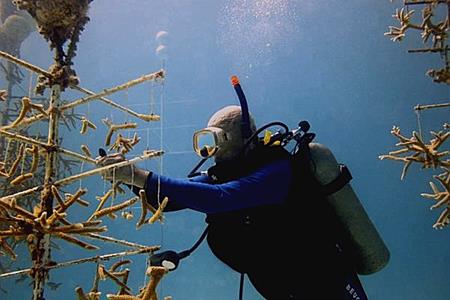 This yearís ADA/CRF
program is set for May 19-20. Both days have a morning of education
and hands-on skills, followed by two afternoons of restoration
diving. The first day of education will review coral biology and
general reef ecology, as well as in-depth review of the underwater
tasks; the second day of education will discuss the different types
of restoration that exist, the different types of methodology that
have been tested and where we are planning to go in the future. The
restoration dives will be a mix of nursery work, monitoring and/or
outplanting, depending on the general needs of CRF at the time and
the education/experience interests of the dive group.
This yearís ADA/CRF
program is set for May 19-20. Both days have a morning of education
and hands-on skills, followed by two afternoons of restoration
diving. The first day of education will review coral biology and
general reef ecology, as well as in-depth review of the underwater
tasks; the second day of education will discuss the different types
of restoration that exist, the different types of methodology that
have been tested and where we are planning to go in the future. The
restoration dives will be a mix of nursery work, monitoring and/or
outplanting, depending on the general needs of CRF at the time and
the education/experience interests of the dive group.
Because of the intensity of the program, divers not interested in the certification are welcome to join for the first day, but will not receive PADI certification. The cost of the second day of the two-day program has not yet been finalized, as that will depend on the number of participants. However, those who are interested may register now to reserve your spot by booking the first day at $130, which will include all training, boat fees and lunch. Please email me when you book the May 19 program to indicate your intention to stay for the second dayís activities and receive your PADI Specialty Diver certification. I will then update everyone when the price is finalized.
The reefs need everyone to pitch in and help. Please do your part. And please promote CRF to your friends and colleagues. Check them out at www.coralrestoration.org
![]()
TV
Shows... You Knew this was Coming After those Movies
--by
Jerry Kosakowski
Letís start with one that is set in the Keys. Yes, there is one, on
Netflix, so if you are not streaming here is one reason to start.
The series is called Bloodline (view its description on IMDB at http://www.imdb.com/title/tt3520702/.
We are now on the 3rd year. It is mostly the upper Keys. US 1 is
featured in every show. 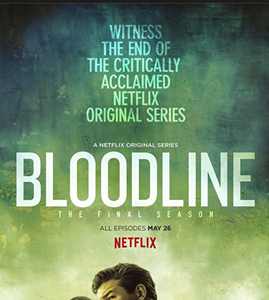
The story line is about the Rayburn family and of course, whatís popular today: drugs, sex and killings. How can one not expect that? Every episode is filled with action. You can watch and constantly think: Iíve been there. I recognize that. So, it makes the watching a little more interesting.
Letís face it, being at the location of a movie site or a book tale certainly adds interest. I find myself watching some YouTube video about the RVN (Republic of Vietnam) and the 173rd Abn (Airborne Brigade) unit and then recall, ďI was on that mountaintop, I went up that pass." Then when I start yelling "Yeah, the grandkids know what I am doing." Maybe you will be doing that when you watch this series. Donít worry about your spouse, sheíll get used to it. I think. Maybe not, because she is always yelling out: "Are you talking to yourself?Ē Of course, I am, there is no one with me. So, I invite her to watch the action, but she declines every time.
If that happens to you donít worry about it. What do they know? In my case it is everything, and she lets me know it. Maybe you have one that isnít that way, but I digress. At any rate, give this series a try and let me know what you think.
![]()
--by Daryl Johnson
This year the mini-season falls on July 25th and 26th. Make sure to always verify dates and regulations at myfwc.com. It begins at 12:01 am on Wednesday and ends at 12:00 midnight on Thursday. The regular 8-month lobster season is always August 6 through March 31. So why are we writing an article about something that happens months from now? Well for one reason, most Florida diver fatalities ( http://www.scubaboard.com/ ) occur during the lobster mini-season, where every unprepared diver goes out at midnight on an overcrowded dive boat with a lot of divers that have not been in the water for a year.
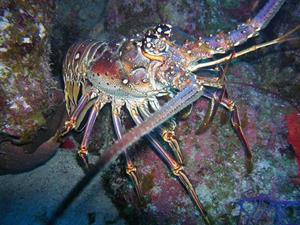
First things first, make sure that you get your equipment serviced now, since the dive shops will get overloaded the closer you get to lobster season, and you will pay more and get slower service, not to mention, there is always the possibility that someone in a hurry will not service your equipment properly. So, I recommend that you go diving after your equipment has been serviced to make sure everything is working correctly at least once before lobster season.
If it has been a while since you have been diving, the May 12th ADA Scuba Skills (see the article in this newsletter) tune-up session would be ideal to get you ready.
There are many ways to catch lobster, but my favorite is with a lobster loop. Lobster instinctively walk backwards when feeling threatened, so place the loop behind the tail and tickle them a bit to get them to move backwards. Once the tail is in the loop, pull back hard on the handle so that the loop contracts around the tail and captures the beast!
Always make sure that you carry a measuring device with you to check each lobster's tail and the carapace and verify they meet the minimum requirements. You CANNOT bring only a lobster tail up from a dive! You must bring the entire lobster up in case the boat gets stopped and checked to make sure all the lobster are of a legal size. Also, you cannot take egg-bearing females which are readily identifiable by the bundle of red eggs on the tail's underside. If you are under the age of 65, you must have a Florida saltwater fishing license and a Lobster stamp in order to hunt them. They can be obtained online at http://myfwc.com/fishing/ for a reasonable fee and you must have them with you.
Finally, once you get to the dock you need to clean themÖand I will gladly tell you how the next time I see you on a dive. Alternatively, call me at 954-591-1161óitís just a bit too graphic to put in a newsletter!!
![]()
One of the new dive products out on the market is the Henderson Aqua Lock Wetsuit. The following are some of the many features as illustrated on the Leisure Pro web site.
- Henderson 3mm, 5mm, & 7mm Men's Aqua Lock Jumpsuit
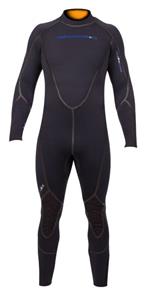
- Interlocking Wrist, Ankle and Neck Openings
- Liquid Taped Aqua Lock Seams
- Double Glued & Blind Stitched
- Golden Micro Fleece Lining
- Aquasilk Exterior Laminate
- PK G-Lock Water Resistant Rear Zipper Entry
- Zipper Tab Leash for Easy Self Donning
- Duratex Knee Pads
- Adjustable Collar
- 3mm, 5mm, 7mm Neoprene
- Available in Multiple Sizes
- 1 Year Head to Toe Limited Warranty
- 10 Year Limited Zipper Warranty
During the summer months in above-eighty degree water, any old wet suit can perform well. The warm temperatures in our waterways donít require suits to do much work insulating the divers body. In the winter itís a different story, the South Florida water temperature can drop to the low sixties.
Throughout my years of diving I have purchased multiple brand name wetsuits and truthfully, I have been extremely disappointed with their performance in cold water. The suits were unable to supply enough warmth to make the dive comfortable, or even in some cases, make any noticeable change. Diving in the winter became so unbearable that I discontinued any diving activity when the water temperatures dropped below eighty degrees. Recently I was introduced to the Henderson Aqua lock 3mm wetsuit. In the last couple of years out of necessity, Iíve had to perform multiple work dives during the winter months, with water temperatures that varied from as low as fifty-seven degrees, to seventy-two degrees Fahrenheit. The Aqua Lock exceeded all performance expectations in the lower temperatures. Upon entering the water the seals allow very little initial water penetration. This technique of restricting the water entering the suit reduces the work needed to warm the diver. The Aqua Lock efficiently and rapidly warms the small amount of water penetrating, allowing the diver to experience a comfortable dive. I began researching why this suit works so well. I discovered that the design of the suitís seals work together with the fleece lining, creating a working design similar to a dry suit. I also learned that this, like all wetsuits are to be worn snug, unlike a body suit that perfectly covers all curves of a diver and is exhausting to don. The tighter the suit and the more the thickness is squeezed and stretched, the less it can perform the insulation task to keep the diver warm. Suits are like sponges, if you squeeze the sponge and dunk it, itís unable to absorb or retain water. The wet suit has the same problem; itís unable to retain water or heat, greatly diminishing its thermal capabilities. My suggestion to all divers is, if you think you are a small, medium, or large, try the next larger size. A wet suit should slide on with some ease and feel snug, not restrictive. You will notice an astonishing change in the suitís performance during your dives in the coastal Florida summer or winter water temperatures. The Henderson 3mm Aqua Lock is not cheap. The retail price runs just under $400. You will need to carry additional weight to balance the suitís positive buoyancy. The 3mm is comfortable and flexible to wear. This suit will extend your dive season throughout the winter months.![]()
Each year, Americaís Largest Consumer Scuba and Dive Show takes place in Secaucus, New Jersey. The International Imaging Competition gives underwater photographers and videographers a chance to compete with peers from across the world. Several winners, including Best of Show, were taken right here in South Florida
Check out the Beneath the Sea 2018 Imaging Contest Winners here.
 Steven
Kovacs Moore Haven, FL
Steven
Kovacs Moore Haven, FLEquipment: Nikon D7000, 60mm lens, Ikelite housing and strobes
Location: Palm Beach, Florida
You Know Your Buddy
Hates You If....?
He gives you the "wait here" sign and you are still on the boat?
He "forgets" to close your dry suit zipper?
When you give him the out of air signal, he passes you his snorkel?
When you indicate you are low on air, he writes on his slate "I'll get you some" and swims off?
You give him the "OK" signal and he gives you the finger?
He spits in your mask for you, but you haven't taken it off yet?
![]()
Strangely enough, it was by not diving enough. Yup, tell the wife youíre quitting your job and going diving more. What could possibly go wrong?
Well, for starters, the $53 million was attached to a turtle, specifically a loggerhead, so concentrate on them exclusively. Donít waste your time looking at anything else. Why? Because they attract bundles of cocaine, wrapped in plastic (for preservation) and tied off with rope. In this particular instance, there were 26 separate packages tied together, with the afore-mentioned street value of $53 million. Hmmm, if we got together and spread out to search, it would still be worth it.
One problem however, it was the Coast Guard that located this swimming mass. That poor turtle didnít even know he had struck it rich. But he did live to tell his friends. The theory is a speeding boat carrying the contraband spotted the Coast Guard and threw it out.
Folks, this was in our backyard. That old smuggling capitol Key West, is still at it. Thatís where to go when you tell your significant other (letís not be sexist) you are on this quest.
Oh, one caution to beware. They did catch 24 smugglers during this special operation (no wonder they threw it away so quickly). As a side note, the Coast Guard also recovered 23 meters of line to prevent further entanglements.
Keep your eyes peeled for those struggling turtles and inform the Captain to slow down and investigate your finding. Better yet, rent your own boat and donít speed, it attracts the Coast Guard.
Good Luck and let me know how this works out for you.
![]()
Want your newsletter delivered via snail-mail? Contact the webmaster and request a printed copy. Be sure to put "ADA Newsletter" in the subject.
![]()
If so, please email or call us with your current information. You may send an email to: Dr. Dan Baeza, Membership Chair at ActiveDiversInfo@gmail.com. You can also call Dan at 954-260-8225 and leave a message with your new contact information.
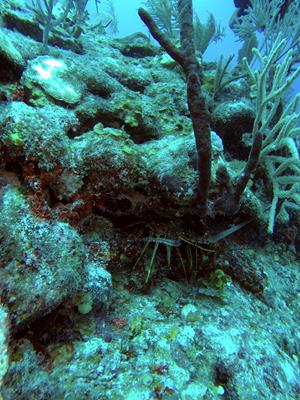
Show your pride in the best dive club anywhere! Sizes small, medium, large, xlarge, xxlarge. Some tank tops available also. All shirts are $10 each. CALL LON AT 305-251-4975 AND PLACE YOUR ORDER TODAY!. Lon will deliver it to you on your next dive


A
Major Problem: In a Word?
Plastics
This year a whale was discovered to have a DVD in his stomach from 2014. You would think the corrosion from the stomach would have destroyed it but not so. It is that bad. In fact, it is estimated that 32% of all plastic winds up in the oceans. That is an amazing figure. But more amazing is the fact that by 2050, it is expected to double.
One problem is that only 2% is recycled. I have two recycling containers but the trash people pick it up and place it into the same truck as the regular trash. I donít believe it is being recycled and I am paying extra for this?
A simple plastic bag takes 100 years to decompose. At the rate we are polluting the oceans by 2050 (again) there will be more plastic than fish. 56% of marine animals have ingested plastic.
One garbage truck in being dumped into the oceans every minute That is 8 million tons a year. Over 100 million marine animals die every year from ingesting plastic. What will be left? 46,000 pieces of plastic are in every square mile of ocean. Is there any hope?
Yes, there is. There is the Ocean Clean Up company that is hard at work. They drag nets along the bottom and gather the waste for removal. There are also wax worms that specifically eat plastic. How that will work out is still being developed. In the meantime, letís all do our best to not to place any plastic in our playground.